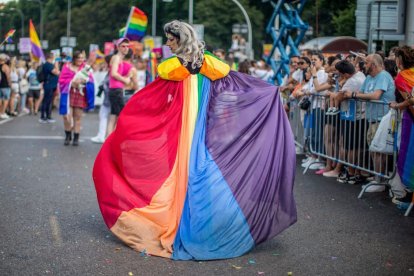More LGBT members than ever?
Several studies have found that the number of people who identify themselves as gay, lesbian or transgender does not match the statistics of sexual activity.

(Cordon Press)
An article stating that nearly 40% of Brown University students identify as LGBT has reopened the debate on the causes and accuracy of the exponential growth of young people who are self-identify as members of this community in the last decade. The study, published in 2018, pointed to "social contagion" as one of the most prominent causes for this boom. The report, by Lisa Littman, was censored by Brown University authorities due to the backlash it received.
According to the Brown Daily Herald, (the university's institutional newspaper), the number of students identifying as LGBT has increased from 14% in 2010 to 38% in 2023. These figures are five times the national rate, which also grew during this period. According to the media outlet, "since the fall of 2010, Brown's LGBTQ+ population has increased significantly. The gay or lesbian population has increased by 26% and the percentage of students who identify as bisexual has increased by 232%. Students who identify as other sexual orientations within the LGBTQ+ community have increased by 793%."
LGBT "social contagion"
This is not the first time Brown University has been in the news for LGBT-related information. In 2018, Lisa Littman published the study, "Reports from parents of adolescents and young adults who perceive signs of a rapid onset of gender dysphoria," in which she developed the idea about the "rapid onset of gender dysphoria," associating it with "social contagion" to explain the rise of adolescents and young adults claiming to be trans. As stated in the purpose of the study:
YouTube and Tumblr singled out by parents
During her research, Littman asked parents to identify "the sources they considered most influential in their children becoming dysphoric. The most frequently answered influences were YouTube transition videos (63.6%), Tumblr (61.7%), a group of friends they know in person (44.5%), a community/group of people they met online (42.9%) and a person they know in person (not online) 41.7%."
The research has been in the crosshairs of the defenders of gender ideology since it was first published, leading to its withdrawal from the center and the appearance of numerous studies that claim to prove the opposite thesis. Attacks by trans and LGBT influencers have also multiplied, without any scientific criteria. However, there have also been studies that follow the line opened by Littman's paper.
"Socio-political factors"
For example, the study "Born this way?" from Eric Kauffman published in May 2022, casts doubt on the reality of data such as those published by the university, noting that the number of people who identify as LGBT has been increasing in recent years, and this figure is much higher than those who actually engage in sexual activity. according to this identification. In fact, this analysis points out that the figures on sexual activity of gay or bisexual people remained at 2008 levels. Thus, according to their data, most of the women who declared themselves bisexual had only slept with men in the last five years.
For the author, the explanation for this proliferation of people who identify as LGBT is conditioned by social pressure, and he considers that much of it is due to the impact of "socio-political factors". Among these, influencers and "queer" content that can be found on the internet and especially on social media are of great importance. Some claim that overexposure to this content is causing a "social contagion," while others consider that those who turn to this type of content and personalities do so seeking advice and protection.
Heterosexual progressives more likely to identify as LGBT
Kauffman's research also points out that there is a greater propensity among people with heterosexual sexual behavior who consider themselves progressive to identify as gay or bisexual. This is especially noticeable among women of this ideology. It is also noteworthy that humanities students are more prone to to declare themselves LGBT than those in the sciences, with nearly 10 percentage points difference. Those pursuing higher education related to race or gender overwhelmingly (52%) consider themselves members of the LGBT community versus 25% of students in other fields who identify as such.
One fact that was of considerable concern to the researcher was mental health. According to his research:
"If you start treatment, all your problems will disappear"
Kauffman's report was among the last to reinforce Hittman's thesis, although not the first. Abigail Shrier also warned about "a new proliferation due to the youth exposure to transgender-related resources." The author also points to other sources such as when a "school organizes an assembly to celebrate gender travel, or hosts a Gay-Straight Alliance club that pushes gender ideology."
Children's overexposure to screens during lockdowns
Even the trans doctor who goes by the name Erica Anderson warned about the danger of overexposure to screens for children during the lockdowns imposed during the COVID-19 pandemic. It also warns that children often follow content creators of the same age, fostering the idea of belonging to a peer group. Both factors are present in the trans phenomenon.
"Skyrocketing" number of youth who identify as LGBT
The "dizzying" rise of young Americans identifying as lesbian, gay, bisexual or transgender led Ross Douthat to study what he called the new "LGBTQ culture war" in politics and the media. Douthat outlined three possible explanations for the phenomenon:
1. LGBT, like being left-handed, is a real expression of human physiological diversity, which until now had been repressed by conservative social norms.
2. The rise of LGBT represents a form of youthful exploration, and many will re-identify as heterosexual and cisgender in adulthood.
3. Alternative sexual identities are a form of social contagion, incubated on the internet and by educational and medical institutions.
Trans influencer, 'contagion' or refuge?
Defenders of gender ideology argue that it is not a matter of "social contagion," but rather that awareness and tolerance have grown. They also stress that it is not that trans or LGBT influencers "convert" children, but that the community gives a place for young people with concerns about their sexual orientation a place to go for information and a "refuge."
RECOMMENDATION





















